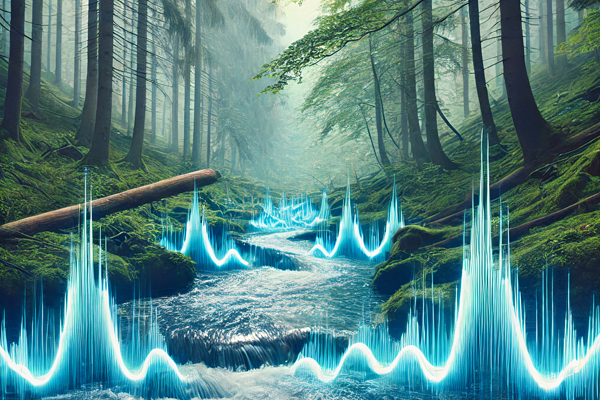PARLANDO
Laufzeit:
Öffnungszeiten:
Tuesday - Friday 2 - 7 pm
and by appointment
Eröffnung:
Termine:

A neural network listens to the sound of a river and recognizes fragments of human speech.
A neural network listens to the sound of a river and recognizes fragments of human speech.
In Parlando, the animistic ritual of listening to the river is taken over by a speech recognition machine (deep learning). A new, independent text is created from the flow of words that are “read” from the sounds and noises of the water.
In Parlando, the limits of AI (which, due to its programming, searches for and finds language in everything) are the driving force behind the artificially poetic text creation.
By interpreting the sound of the river as a human voice, it actually becomes the text and the supposedly hidden message of the gurgling, parading water.
Technology: Spectral sound analysis, deep learning
The French inventor and self-proclaimed linguist Jean-Pierre Brisset formulated the idea that our language originated from water as follows: “Water created everything, even language, which is made of water”.
Associative listening on the banks of a river is considered a meditative exercise. Sometimes the brain constructs the impression of whispered or spoken language as a result of an acoustic illusion. The sound of flowing water contains a wealth of frequencies, their rhythmic sequence resembling the speed of speech.
In this work, Ulla Rauter sends a neural network on a search for traces of human speech in the sounds of a river. With the help of AI, she attempts to recognize words and word fragments hidden in the rushing water and bring them to the surface. To do this, it uses acoustic pattern recognition based on spectrograms. A spectrogram is the visual fanning out of a sound in volume, frequency and time.
She has been working artistically with spectrograms for several years. They fascinate Ulla Rauter because of their great aesthetic appeal - she sees them as vocal X-ray images - and as a kind of code they contain not only the spoken word, but also a wealth of paralinguistic information. In her works, she has created hand-drawn spectrograms which - when set to music - become an artificial voice as a pure construct of our brain.
Ulla Rauter also uses spectrograms in her work with the river. She trains the computer program with her voice by repeatedly speaking individual words and short phrases. She approximates her voice to the sound of the river by subjecting it to a sound convolution - the signal of her voice is multiplied by the spectrum of the river. (This shifts the focus away from voice-specific characteristics and more towards the dynamics and rhythm of the speech).
She then positions a microphone on the bank of a flowing body of water. The neural network now listens to the sound of the river as if it were human speech. By never playing the river itself to the program, but only ever giving it her voice as a reference, it now tries to recognize human speech patterns in everything that is played.
Analogous to the human brain, the expectation leads to a comparison of the new with the familiar. Similar patterns in the acoustic texture are interpreted as words and strung together to form sentences and phrases. These in turn can be loaded with meaning by us as we read - the flow sometimes seems to reveal a deeper truth, a message.
Here, too, our brain's incessant search for meaningful connections and patterns comes into play.
